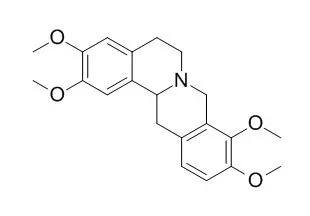| In vitro: |
| Life Sci. 2010 Jul 3;87(1-2):55-63. | | Protective effects of tetrahydropalmatine against gamma-radiation induced damage to human endothelial cells.[Pubmed: 20562023 ] | Irradiation-induced damage to pulmonary endothelial cells is thought to be an important mediator of the pathogenesis of radiation pneumonopathy. Tetrahydropalmatine (THP) has been shown to have a protective effect against oxidative stress. This study was designed to investigate the potential radioprotective effect of THP against irradiation-induced endothelial cellular damage and to elucidate the underlying mechanisms.
METHODS AND RESULTS:
Human EA.hy926 cells were treated with THP and irradiation. Cell viability was measured using a 3-(4,5-dimethylthiazol-2-yl)-2,5-diphenyltetrazolium bromide (MTT) assay. For the detection of apoptosis, morphological observation, flow cytometry and a caspase-3 activity assay were employed. The expression of cytochrome-c and Bax/Bcl-2 protein were detected by western blot analysis. Generation of reactive oxygen species (ROS) was measured by flow cytometry. Malondialdehyde (MDA), lactate dehydrogenase (LDH), glutathione (GSH) and superoxide dismutase (SOD) were measured to assess cellular oxidative stress induced injury.
Preincubation of EA.hy926 cells with THP before gamma-radiation resulted in significant inhibition of apoptosis and enhancement of cell viability, as revealed by morphological observation, flow cytometry and MTT assay. THP significantly reduced intracellular ROS formation, levels of intracellular MDA and LDH, and enhanced the production of intracellular antioxidants (GSH and SOD) in EA.hy926 cells. Meanwhile, THP also inhibited the decrease of intracellular mitochondrial membrane potential (psim), caspase-3 activation, cytochrome-c release and reduced Bax/Bcl-2 ratio in THP pretreated, irradiated cells.
CONCLUSIONS:
Our findings demonstrated THP could effectively protect endothelial cells against gamma-irradiation injury, which could potentially be applied to the prevention of endothelial cell dysfunctions associated with ionizing irradiation-induced lung injury. |
|
| In vivo: |
| Phytomedicine. 2014 Sep 25;21(11):1287-91. | | L-tetrahydropalmatine inhibits methamphetamine-induced locomotor activity via regulation of 5-HT neuronal activity and dopamine D3 receptor expression.[Pubmed: 25172791] | Methamphetamine (METH) is a psychomotor stimulant that produces hyperlocomotion in rodents. l-Tetrahydropalmatine (l-THP) is an active ingredient found in Corydalis ternata which has been used as a traditional herbal preparation in Asian countries for centuries, however, the effect of l-THP on METH-induced phenotypes largely unknown.
METHODS AND RESULTS:
In this study, to evaluate the effect of l-THP on METH-induced psychotropic effects, rats were pretreated with l-THP (10 and 15 mg/kg) before acute METH injection, following which the total distance the rats moved in an hour was measured. To clarify a possible mechanism underlying the effect of l-THP on METH-induced behavioral changes, dopamine receptor mRNA expression levels in the striatum of the rats was measured following the locomotor activity study. In addition, the effect of l-THP (10 and 15 mg/kg) on serotonergic (5-HTergic) neuronal pathway activation was studied by measurement of 5-HT (80 μg/10μl/mouse)-induced head twitch response (HTR) in mice. l-THP administration significantly inhibited both hyperlocomotion in rats and HTR in mice. l-THP inhibited climbing behavior-induced by dopaminergic (DAergic) neuronal activation in mice. Furthermore, l-THP attenuated the decrease in dopamine D3 receptor mRNA expression levels in the striatum of the rats induced by METH.
CONCLUSIONS:
These results suggest that l-THP can ameliorate behavioral phenotype induced by METH through regulation of 5-HT neuronal activity and dopamine D3 receptor expression. | | Neuropharmacology. 2007 Nov;53(6):771-82. | | Levo-tetrahydropalmatine inhibits cocaine's rewarding effects: experiments with self-administration and brain-stimulation reward in rats[Pubmed: 17888459 ] | It was recently reported that levo-Tetrahydropalmatine (l-THP), a dopamine (DA) D1 and D2 receptor antagonist purified from the Chinese herb Stephanie, appears to be effective in attenuating cocaine self-administration, cocaine-triggered reinstatement and cocaine-induced conditioned place preference in preclinical animal models.
METHODS AND RESULTS:
The present study was designed to contrast l-THP's effects on cocaine self-administration under fixed-ratio (FR) and progressive-ratio (PR) reinforcement, and to study l-THP's effects on cocaine-enhanced brain stimulation reward (BSR). Systemic administration of l-THP produced dose-dependent, biphasic effects, i.e., low-to-moderate doses (1, 3, 10 mg/kg) increased, while a high dose (20 mg/kg) inhibited cocaine self-administration behavior under FR2 reinforcement. The increased cocaine self-administration is likely a compensatory response to a reduction in cocaine's rewarding effects, because the same low doses of l-THP dose-dependently attenuated cocaine self-administration under PR reinforcement and also attenuated cocaine-enhanced BSR. These attenuations of PR cocaine self-administration and cocaine-enhanced BSR are unlikely due to l-THP-induced sedation or locomotor inhibition, because only 10 mg/kg, but not 1-3 mg/kg, of l-THP inhibited locomotion, sucrose self-administration and asymptotic operant performance in the BSR paradigm. In vivo microdialysis demonstrated that l-THP slightly elevates extracellular nucleus accumbens DA by itself, but dose-dependently potentiates cocaine-augmented DA, suggesting that a postsynaptic, rather than presynaptic, DA receptor antagonism underlies l-THP's actions on cocaine reward.
CONCLUSIONS:
Together, the present data, combined with previous findings, support the potential use of l-THP for treatment of cocaine addiction. |
|






 Cell. 2018 Jan 11;172(1-2):249-261.e12. doi: 10.1016/j.cell.2017.12.019.IF=36.216(2019)
Cell. 2018 Jan 11;172(1-2):249-261.e12. doi: 10.1016/j.cell.2017.12.019.IF=36.216(2019) Cell Metab. 2020 Mar 3;31(3):534-548.e5. doi: 10.1016/j.cmet.2020.01.002.IF=22.415(2019)
Cell Metab. 2020 Mar 3;31(3):534-548.e5. doi: 10.1016/j.cmet.2020.01.002.IF=22.415(2019) Mol Cell. 2017 Nov 16;68(4):673-685.e6. doi: 10.1016/j.molcel.2017.10.022.IF=14.548(2019)
Mol Cell. 2017 Nov 16;68(4):673-685.e6. doi: 10.1016/j.molcel.2017.10.022.IF=14.548(2019)